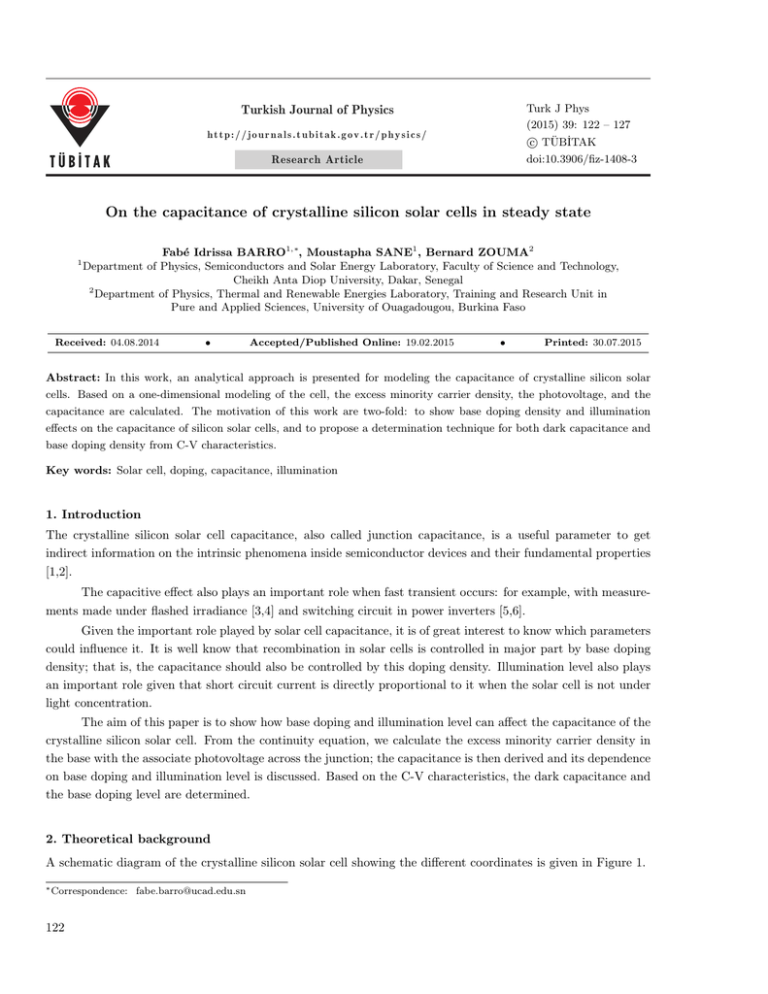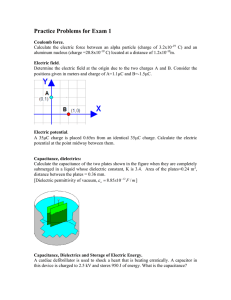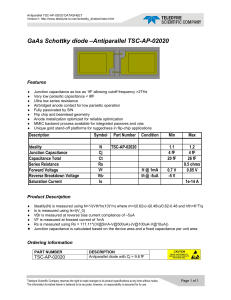
Turk J Phys
(2015) 39: 122 – 127
Turkish Journal of Physics
http://journals.tubitak.gov.tr/physics/
c TÜBİTAK
⃝
doi:10.3906/fiz-1408-3
Research Article
On the capacitance of crystalline silicon solar cells in steady state
1
Fabé Idrissa BARRO1,∗, Moustapha SANE1 , Bernard ZOUMA2
Department of Physics, Semiconductors and Solar Energy Laboratory, Faculty of Science and Technology,
Cheikh Anta Diop University, Dakar, Senegal
2
Department of Physics, Thermal and Renewable Energies Laboratory, Training and Research Unit in
Pure and Applied Sciences, University of Ouagadougou, Burkina Faso
Received: 04.08.2014
•
Accepted/Published Online: 19.02.2015
•
Printed: 30.07.2015
Abstract: In this work, an analytical approach is presented for modeling the capacitance of crystalline silicon solar
cells. Based on a one-dimensional modeling of the cell, the excess minority carrier density, the photovoltage, and the
capacitance are calculated. The motivation of this work are two-fold: to show base doping density and illumination
effects on the capacitance of silicon solar cells, and to propose a determination technique for both dark capacitance and
base doping density from C-V characteristics.
Key words: Solar cell, doping, capacitance, illumination
1. Introduction
The crystalline silicon solar cell capacitance, also called junction capacitance, is a useful parameter to get
indirect information on the intrinsic phenomena inside semiconductor devices and their fundamental properties
[1,2].
The capacitive effect also plays an important role when fast transient occurs: for example, with measurements made under flashed irradiance [3,4] and switching circuit in power inverters [5,6].
Given the important role played by solar cell capacitance, it is of great interest to know which parameters
could influence it. It is well know that recombination in solar cells is controlled in major part by base doping
density; that is, the capacitance should also be controlled by this doping density. Illumination level also plays
an important role given that short circuit current is directly proportional to it when the solar cell is not under
light concentration.
The aim of this paper is to show how base doping and illumination level can affect the capacitance of the
crystalline silicon solar cell. From the continuity equation, we calculate the excess minority carrier density in
the base with the associate photovoltage across the junction; the capacitance is then derived and its dependence
on base doping and illumination level is discussed. Based on the C-V characteristics, the dark capacitance and
the base doping level are determined.
2. Theoretical background
A schematic diagram of the crystalline silicon solar cell showing the different coordinates is given in Figure 1.
∗ Correspondence:
122
fabe.barro@ucad.edu.sn
BARRO et al./Turk J Phys
BSF (p+)
Emitte r (n+)
Incid e nt lig ht
metal grid
Base (p)
x=0
x=H
Figure 1. Schematic diagram of a back surface field (BSF) silicon solar cell.
When illuminated, three major phenomena occur inside the solar cell: carrier generation, recombination,
and drift/diffusion. In steady state, if we assume a quasineutral base, these phenomena can be described by
the following equation:
G(x)
∂ 2 δ(x) δ(x)
− 2 =−
.
2
∂x
L
D
(1)
δ is the excess minority carrier density, L is their diffusion length, and D is their diffusion coefficient.
The diffusion coefficient can be written as [7]:
∂ 2 δ(x) δ(x)
G(x)
− 2 =−
,
∂x2
L
D
(2)
with Nb being the base doping density and Vt the thermal voltage: Vt = kT/q. k is the Boltzmann constant,
T the temperature, and q the electronic charge.
The associated excess minority carrier lifetime is given by [7]:
∂ 2 δ(x) δ(x)
G(x)
− 2 =−
∂x2
L
D
(in µs).
(3)
The diffusion length can then be deduced as:
∂ 2 δ(x) δ(x)
G(x)
− 2 =−
.
2
∂x
L
D
(4)
Carrier generation rate G(x) at depth x in the base is written in the following form [8,9]:
G(x) =
3
∑
ai · e−bi ·H .
(5)
i=1
n indicates illumination level given to be the ratio between incident power and AM1.5 reference power; coefficients a m and b m are tabulated values obtained from solar irradiance and the dependence of the absorption
coefficient on the illumination wavelength [10].
The solution of Eq. (1) is:
(x)
3
( x) ∑
+ C2 · exp −
+
Km · exp (−bm · x).
δ(x) = C1 · exp
L
L
m=1
(6)
Coefficients C 1 and C 2 can be evaluated if we consider the two following boundary conditions:
123
BARRO et al./Turk J Phys
• at the junction (x = 0):
∂δ(x)
Sf
|x=0 =
· δ(0),
∂x
D
(7)
∂δ(x)
Sf
|x=0 =
· δ(0).
∂x
D
(8)
• at the backside (x = H):
Sb is the back surface recombination velocity and Sf is the junction dynamic velocity; the more carrier flow
through the junction, the more Sf is. That is, Sf traduces the carrier flow through the junction and is then
directly related to the external load conditions [11]. Low Sf values are related to the solar cell operating near
the open circuit contrary to high Sf values, which are related to near short circuit operating conditions.
Since the excess minority carrier density is known, from the Boltzmann relation we can derive the
photovoltage across the junction as:
(
)
NB .δ(x = 0)
+
1
.
(9)
V ph = VT · ln
n2i
V T is the thermal voltage and n i is the intrinsic carrier concentration.
Now let us define the solar cell capacitance C as:
C=
dQ
.
dV
(10)
The capacitance C results from charge variation due mainly to diffusion processes in the solar cell [12–14].
When the solar cell is illuminated, there is a photogeneration process associated to recombination and diffusion
processes. The diffusion process induces a charge variation into the solar cell accompanied by a charge in the
voltage across the cell. It is this charge variation that induces mainly the capacitance of the solar cell under
illumination.
The total amount of charge is:
Q = q · δ (x = 0) ,
(11)
where q is the electronic charge.
Substituting Eq. (11) into Eq. (10), the capacitance becomes:
dδ (x = 0)
.
dV
(12)
dδ (x = 0)
1
· dV .
dSf
dSf
(13)
C =q·
Eq. (12) can be rewritten as:
C =q·
Taking into account Eq. (9) and manipulating Eq. (13), we obtain:
2
q · ni
qδ(x = 0)
Nb
C=
+
= C0 + Cd ,
Vt
Vt
n2
with C0 =
q· Nib
Vt
and Cd =
q·δ(x=0)
Vt
(14)
.
The first term in Eq. (14) is the dark capacitance C o of the cell while the second is the diffusion-related
capacitance C d . It is clear that under illumination only diffusion capacitance predominates.
124
BARRO et al./Turk J Phys
3. Results and discussion
Simulation was performed for various illumination levels, various base doping levels, and various external load
conditions.
We present in Figure 2 a plot of the capacitance versus junction dynamic velocity for various base doping
density.
This figure shows that the solar cell capacitance decreases with increasing junction dynamic velocity Sf.
This behavior can be explained by the fact that when Sf increases, carrier flow through the junction increases
so that there is less and less free carrier in the base. This lack of permanent excess minority carrier near the
junction leads to a decrease in the capacitance.
For low Sf values, the carrier does not cross the junction; it is stored in the base so that we can obtain
higher capacitance values, as noted in Figure 2.
That is, when the solar cell is operating near the open circuit, the capacitive effect will be more important
so that this could impact negatively on the whole efficiency of the system if the solar cell is connected to a
switching circuit or used for measurement purposes.
When the base doping Nb increases, the capacitance decreases and this decrease is more marked for lower
Sf values. Effectively, when the base doping increases, impurity concentration increases also, leading to more
and more recombination of excess minority carrier and then a decrease of the capacitance.
We now present the capacitance profile versus junction dynamic velocity for various illumination levels
in Figure 3.
–4
8.0x10
16
–3
17
–3
18
–3
NB =10 cm
–4
NB =10 cm
6.0x10
–4
5.0x10
–3
NB =10 cm
NB =10 cm
–4
4.0x10
–4
3.0x10
–3
3.0x10
–3
2.5x10
–3
2.0x10
–3
1.5x10
–3
–4
1.0x10
–4
5.0x10
2.0x10
–4
1.0x10
0.0 2
10
n=1
n=3
n=5
n=7
3.5x10
Capacitance (F cm–2)
–3
–4
7.0x10
Capacitance (F cm–2 )
–3
4.0x10
15
10 3
10 4
10 5
Junction dynamic velocity Sf (cm/s)
10 6
Figure 2. Variation of the capacitance as a function of
junction dynamic velocity. The values of base doping are
indicated in the figure.
0.0
102
103
104
105
Junction dynamic velocity Sf (cm/s)
106
Figure 3. Variation of the capacitance as a function of
junction dynamic velocity. The values of illumination level
are indicated in the figure.
We note that solar cell capacitance increases as illumination level increases.
There is a balance between illumination level and base doping level given that the increasing illumination
level acts as a passivating recombination center contrary to base doping, which increases recombination centers.
Care must be taken on increasing the illumination level because there is a limit for the lower injection condition.
Beyond a certain illumination level, our assumption of the base quasineutrality will not be true so that we must
also take into account the electric field in the base.
125
BARRO et al./Turk J Phys
If we turn back to Eq. (14), we can write:
C
n2
q· Nib
=1+
N b · δ (0)
C
N b · δ (0)
so that
=1+
.
n2i
C0
n2i
(15)
Vt
From Eq. (9) we have:
(
exp
V ph
Vt
)
N b · δ(0)
C
=1+
giving
= exp
2
ni
C0
(
V ph
Vt
)
.
(16)
This equation can then be written as:
ln(C) − ln(C0 ) =
V ph
.
Vt
(17)
The capacitance (logarithmic scale) as a function of photovoltage is then a straight line as shown in Figure 4.
15
–3
16
–3
17
–3
18
–3
NB=10 cm
NB=10 cm
NB=10 cm
Capacitance (F cm–2)
–4
10
NB=10 cm
10–5
10–6
0.40
0.45
0.50
0.55
0.60
Photovoltage (V)
0.65
0.70
Figure 4. C-V characteristics of the solar cell. Values of the doping level are indicated in the figure.
The capacitance increases as the photovoltage increases effectively because a photovoltage increase is
related to more and more stored charge in the base, leading to an increase of the capacitance.
From Eq. (17), we can see that the slope of the straight line is 1/V T and it intercepts the capacitance
axis at a value corresponding to the logarithm of the dark capacitance LogC 0 . For a given cell and from its C 0
value, we can deduce the corresponding base doping level by help of the following expression derived from Eq.
(14):
Nb =
q n2i
·
.
V t C0
(18)
Figure 5 illustrates the graphical determination of the dark capacitance from the C-V characteristic; for the
given example, we have:
log(C0 ) ≈ −6.75 giving C0 ≈ 10−6.75 F.
126
BARRO et al./Turk J Phys
Figure 5. Graphic determination of the dark capacitance from C-V characteristics.
4. Conclusion
The capacitance of a crystalline silicon solar cell was investigated; from a one-dimensional model, we pointed
out the effects of base doping, illumination level, and junction dynamic velocity (related to operating point) on
the capacitance. Based on the C-V characteristics, a graphical method has been proposed for the determination
of both dark capacitance C 0 and base doping density Nb.
References
[1] Meier, D. L.; Hwang, J. M.; Campbell, R. B. IEEE T. Electron Dev. 1988, 35, 70–79.
[2] Geerligs, L. J.; Macdonald, D. Prog. Photovolt. Res. Appl. 2004, 12, 309–316.
[3] Roth, T.; Wichmann, D.; Meyer, K.; Orlob, M. Energy Procedia 2011, 8, 82–87.
[4] Edler, A.; Schlemmer, M.; Ranzmeyer, J.; Harney, R. Energy Procedia 2012, 27, 267–272.
[5] Kumar, R. A.; Suresh, M. S.; Nagaraju, J. IEEE T. Power Electr. 2006, 21, 543–548.
[6] Kim, D. K.; Oh, Y. J.; Kim, S. H.; Hong, K. J.; Jung, H. Y.; Kim, H. J.; Jeon, M. S. Transactions on Electrical
and Electronic Materials 2013, 14, 177–181.
[7] Liou, J. J.; Wong, W. W. Sol. Energ. Mat. Sol. C. 1992, 28, 9–28.
[8] Furlan, J.; Amon, S. Solid-State Electronics 1985, 28, 1241–1243.
[9] Mohammad, S. N. J.Appl.Phys. 1987, 61, 767-772.
[10] Rajman, K.; Singh, R.; Shewchun, J. Solid State Electron. 1979, 22, 793–795.
[11] Diallo, H. L.; Maiga, A. S.; Wereme, A.; Sissoko, G. Eur. Phys. J. Appl. Phys. 2008, 42, 203–211.
[12] Hu, C. C. Modern Semiconductor Devices for Integrated Circuits; Pearson/Prentice Hall: Upper Saddle River, NJ,
USA, 2010.
[13] Böer, K. W. Introduction to Space Charge Effects in Semiconductors; Springer-Verlag: Berlin, Germany, 2010.
[14] Neamen, D. A. Semiconductor Physics and Devices: Basic Principles, 3rd ed.; McGraw-Hill: New York, NY, USA,
2003.
127



